The “Father of Modern Rodeo” was truly a renaissance man. He is also known as the “Cowboy of Cowboy Artists,” “Lord Bascom—King of the Canadian Cowboys,” and “rodeo’s first collegiate cowboy.” And even those titles don’t quite capture all of Earl Bascom’s achievements. Throughout his storied career, he was a professional bronc buster, bull rider, trail driver, blacksmith, rodeo champion, cattle rancher, WWII shipfitter, inventor, painter, sculptor, high school teacher, and Hollywood actor.
And amid all these unique and impressive pursuits, his former stake president said, “He was one of those people that I would consider a solid Saint in the kingdom.”
Earl passed away in 1995 at the age of 89, but he left a legacy of faith, hard work, and innovation for his family and rodeo fans alike. So let’s dive into the life, career, and faith of Earl W. Bascom.
Early Life and Lineage
According to the Vernal Express, Earl Bascom was born in a log cabin on the 101 Ranch near Vernal, Utah, on June 19, 1906. But even before he was born, Earl’s family heritage paved the way for his career path in frontier, ranching, and rodeo life. Earl was raised as a member of the Church of Jesus Christ of Latter-day Saint, and both of his grandfathers, Joel A. Bascom and C. F. B. Lybbert, were Latter-day Saint pioneers, frontier lawmen, and ranchers. Earl’s father, Deputy Sheriff John W. Bascom, chased members of Butch Cassidy’s Wild Bunch Gang and outlaw Harry “Mad Dog” Tracy in the late 1880’s. Earl’s great-uncle Ephraim Roberts was a pony express rider, riding from Utah to Southern California and back, and another great-uncle, William Lance, was a soldier in the Mormon Battalion.
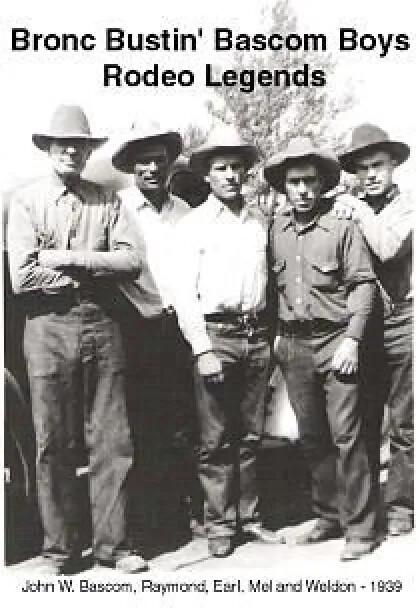
When Earl was six years old, his mother Rachel died of breast cancer in 1912, according to Cowboy Country Magazine. Shortly after, the family moved to Canada, where Earl’s father worked as foreman on the ranch of Ray Knight, the millionaire rancher namesake of the city of Raymond, Alberta, Canada. His father’s fortuitous employer was considered the “Father of Canadian Rodeo” after he promoted and produced Canada’s first rodeo, the Raymond Stampede, in 1902. The Raymond Stampede of 1918 is where Earl entered his first professional rodeo at the age of 12.
Rodeo Career
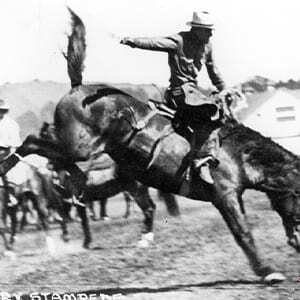
For 23 seasons, between the years of 1916 and 1940, Earl rodeoed professionally and was frequently named rodeo champion. He saw his professional rodeo heyday between 1930 and 1940, and according to The Sun, Earl took second place in the North American Championship and placed third in the rodeo Championship of the World. Throughout his career, Earl took part in every aspect of rodeo competition—“including bareback, saddle bronc, bull riding, steer riding, steer wrestling, steer decorating, wild cow milking, and wild horse racing. He also worked as a rodeo producer, stock contractor, rodeo announcer, pickup man, hazer, rodeo clown, and bullfighter.”
Inventions
According to Cowboy Country Magazine, in 1916, brothers Raymond, Melvin, and Earl Bascom designed and constructed the first known side-delivery rodeo chute. In 1919, the Bascom brothers redesigned their side-delivery chute, requiring only one man to work the gate and eliminating the hazard of riders’ banged-up knees. This ingenious Bascom design is now the standard for rodeo chutes and arenas.
On his own, Earl also invented two important pieces of rodeo equipment: the first hornless bronc saddle back (“mulee”) in 1922 and the first one-handed bareback rigging in 1924. Today, both pieces of equipment are standard issue at all professional rodeos throughout the world.
Wikipedia also lists Earl as the inventor of the first high-cut rodeo chaps in 1926 and the first rodeo exerciser in 1928. He and his brother Weldon produced the first rodeos in the state of Mississippi and the first night rodeos held outdoors under electric lights. Earl’s designs also led to the first first permanent rodeo arena constructed in the state of Mississippi.
Film
In 1917, Earl was in his first Hollywood movie, The Silent Man, starring William S. Hart. Years later, Earl acted as one of the outlaws in the 1954 Hollywood western, The Lawless Rider. Earl’s brother Weldon played the sheriff in the film, and Weldon’s wife, Texas Rose Bascom, was the leading actress.
After retiring in California, Earl and his son-in-law Mel Marion worked with Roy Rogers, being filmed for TV commercials for the Roy Rogers Restaurant chain, according to Wikipedia. Earl and his son John were also featured in the television documentary Take Willy With Ya, a tribute to the life of rodeo champion Turk Greenough.
Art and Teaching
Earl’s formal education as a young student was meager—he was educated in one-room schoolhouses and only completed one full school year, according to Wikipedia. Even without a high school diploma, he was accepted as a student at Brigham Young University in in the fall of 1933. He was a 27-year-old freshman who, in his words, “felt like a wild horse in a pen,” but he had developed a love for art as a child and took every art course BYU offered.
The Provo Evening Herald reported that during his freshman year, Earl won the Studio Guild Award for the best student art work of the year, and he won the award again in 1936. He was a beloved member of the BYU Art Club as a popular entertainer with his cartoon drawings, and Earl graduated from BYU with a degree in Fine Art in 1940, where his fellow art students voted him “most likely to succeed” as an artist.
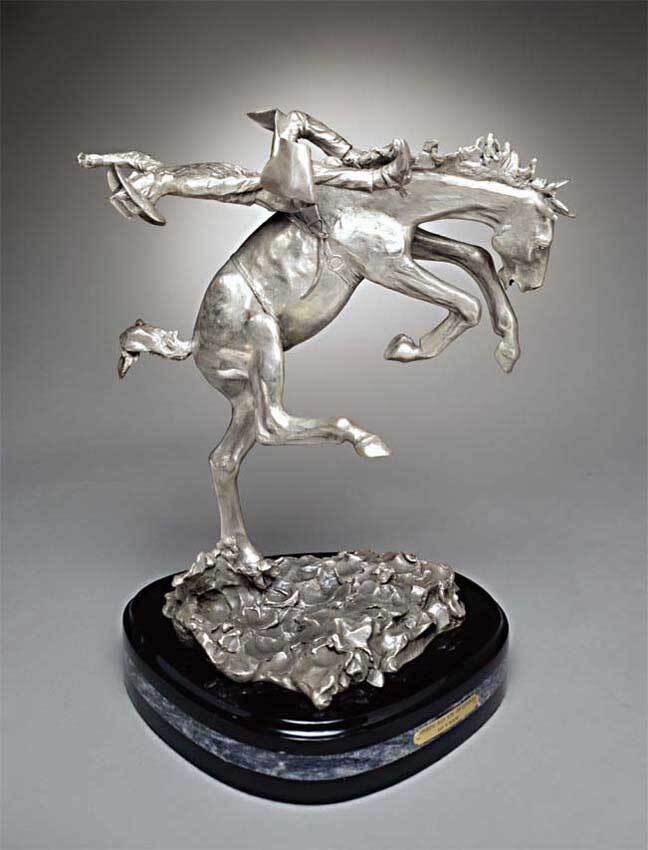
Years after graduating and moving with his wife, Nadine, to California, the couple brought their family back to Utah, where Nadine earned her degree at BYU and Earl qualified for a lifetime teaching certificate. Both Earl and Nadine became teachers after settling back in Victorville, California, in 1966—Nadine teaching elementary school and Earl teaching high school art classes. According to MormonWiki, Earl took sculpture and bronze casting at UC Riverside, launching him into another field of art.
In his later years, Bascom became internationally known as a cowboy artist and sculptor, with his art being exhibited across the United States, Canada, Europe, and Asia. In 1994, Bascom was commissioned by the Texas Longhorn Quincentennial Celebration Committee to produce his sculpture of what was considered “the most authentic example of a classical Texas longhorn steer.”
Earl is quoted to have said of his own art, “I’ve tried to portray the West as I knew it —rough and rugged and tough as a boot but with a good heart and honest as the day is long.”
Awards and Honors
Earl Bascom received countless honors during his lifetime, including induction into four major Halls of Fame—the Canadian Pro Rodeo Hall of Fame, the Alberta Sports Hall of Fame, the National Cowboy & Western Heritage Museum Rodeo Hall of Fame, and Canada’s Sports Hall of Fame. Additionally, he has been inducted into state rodeo halls of fame in Utah, Mississippi, and Idaho, and in 2014 he was named the National Day of the Cowboy honoree. The U.S. House of Representatives also honored Earl Bascom as an “American Hero” in 1985.
Tributes
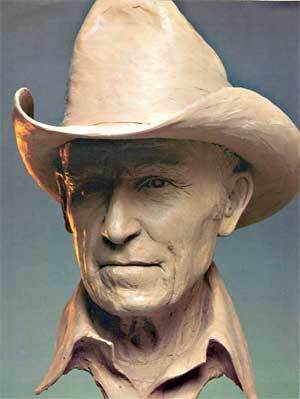
Earl Bascom passed away on August 28, 1995 at the age of 89, on his ranch in Victorville, California. After his passing, Earl was given a tribute honor in the Congressional Record by United States Congressman Jerry Lewis: [Earl Bascom was a] “cowboy hero and a true inspiration … (who) lived one of the most interesting lives ever known in modern cowboy history.”
Cowboy celebrity Roy Rogers, who worked with Earl on TV commercials and was known to be a collector of Bascom’s art, once said, “Earl Bascom is a walking book of history. His knowledge of the Old West was acquired the old fashioned way—he was born and raised in it.”
Ken Knopp, historian of the Mississippi Rodeo Hall of Fame, said that “Earl Bascom is the Michael Phelps of rodeo.“
Faith
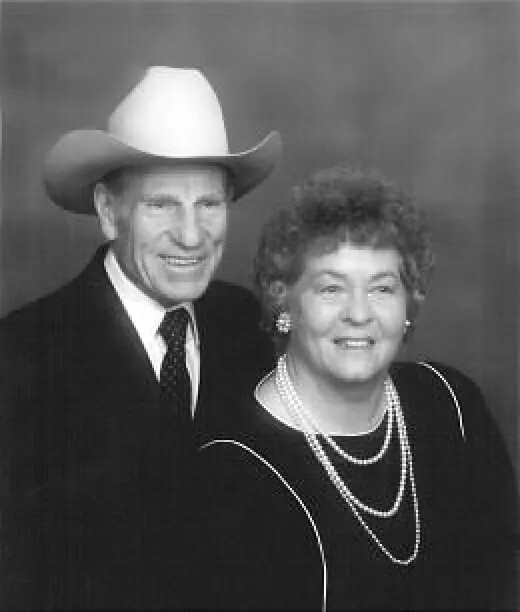
Earl served a full-time mission for The Church of Jesus Christ of Latter-day Saints to the Southern States, according to Church News, which helped lead to his years later spent bringing rodeo to Mississippi. He married his wife, Nadine Diffey, in the Salt Lake Temple in December 1939, and together they raised five children. Earl also served in various Church callings, including as bishop and patriarch of the Barstow and Victorville California stakes.
Brother Donald Bigler served as stake president while Earl was stake patriarch in Southern California.
“He was one of those people that I would consider a solid Saint in the kingdom,” he told Church News.
When Earl was posthumously inducted to the Rodeo Hall of Fame at the National Cowboy and Western Heritage Museum in Oklahoma City, Oklahoma, in 2013, his youngest son, John A. Bascom, attended the ceremony on his behalf.
“He was faithful and true to the gospel,’” John told Church News. “Many looked up to him. He was a spiritual man, always honest in his dealings.”
Editor's note: Special thanks to Cowboy Country Magazine, AskArt.com, Rodeo News, The National Cowboy Museum, MormonWiki.com, Church News, The Vernal Express, and Wikipedia for additional details on Earl Bascom’s life and career.

